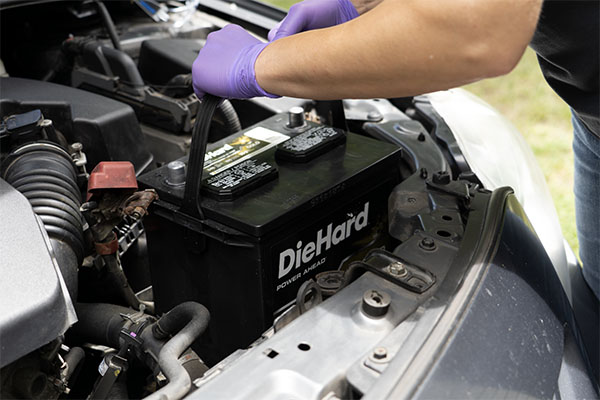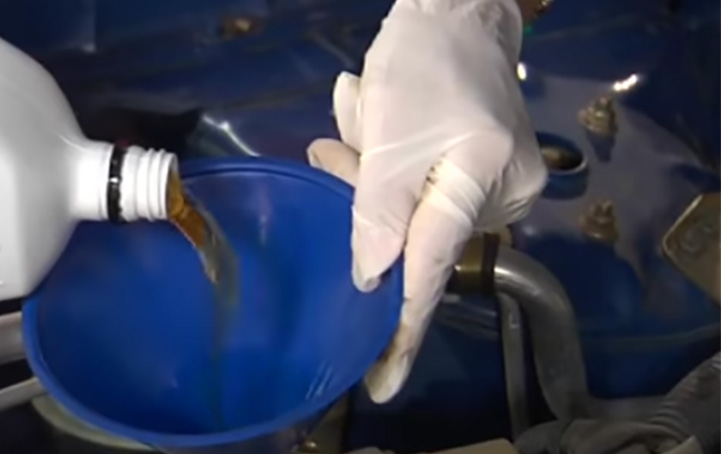You've heard that old advice countless times: “You should change your oil every three months, or 3,000 miles." While commonly followed, is this rule still true today? How often should you really change your oil? Let's take a look at the specifics of oil changes, including choosing the right oil for your vehicle.

Oil Change Frequency
If you're the DIY type who changes your own oil, you probably return the used oil back to the retailer for recycling. But that brings up a good question: if it can be recycled and used again, why even change it at all? It's not that the oil goes bad, but the oil in your engine becomes contaminated and loses efficiency. You want clean oil lubricating your engine, not contaminants and grit.
The slight clearance between moving parts—say, between piston rings and cylinder walls—allows trace amounts of burned fuel to mix with the oil, contaminating it. Over time, these contaminants will turn your oil dark. The oil filter keeps a lot of that junk from circulating in your engine, but it has a limited capacity. When the filter can no longer keep the contaminants out of your motor oil, it's time for an oil change. If you go too long without one, the contaminants build up and cause costly sludge issues and reduce the oil's viscosity.

What is Oil Viscosity?
Viscosity is a science term that sounds like it would mean oil's thickness. That's not quite right though. Viscosity is actually the “measure of its resistance to deformation at a given rate" in geek speak, or simply a fluid's resistance to flowing. High viscosity fluids like molasses are resistant to flowing compared to low viscosity fluids, such as water, that flow freely. So the viscosity measurement on the front of the oil bottle is its resistance to flow at a given temperature. Let's look at how to read the numbers.
The Society of Automobile Engineers developed a scale to grade engine oils for protection during cold starts in the winter and at operating temperature in the summer. You've seen this on oil containers in the XW-XX format. The first number is the winter (W) rating for cold starts in 0 degrees Fahrenheit, while the second number is the rating for an operating temperature of 100 degrees Celsius. Some common oil viscosities are 0W-30, 5W-30, and 10W-30, meaning they all provide the same protection at operating temperature, but the 0W being the easiest flowing in winter temps. This is a good thing in Alaska, as you don't want to try and start your F-150 with the aforementioned molasses in the crankcase.
Can I use a different oil viscosity?
Like many engine related questions, the answer is maybe. Swapping for a higher viscosity oil can provide more protection when hot, but it will also cost you some power and gas mileage. On the other hand, switching to a lower viscosity oil *could* gain you some additional horsepower, if you remember playing Gran Turismo, along with increased gas mileage. The potential downside is less engine protection between critical parts. Is that really worth 2 horsepower or a 0.5 MPG gain to lessen engine protection? Probably not. Note that the manufacturer's engineers used a specific weight of oil when building, testing, and certifying your engine. If you want all the horsepower, gas mileage and low emissions that the factory says the engine makes, then you want to stick with the oil it was designed for. If your oil cap doesn't list it, consult your owner's manual.
Oil Change Mileage
Many drivers stick with the 3,000 mile oil change guidelines because their owner's manual used to recommend that back on their 1967 Camaro, or even before. The 3,000-mile oil change guideline has likely been around longer than your parents have been driving. Many drivers still stand by it today. There are a lot of arguments here, as many of us have been rewarded with a reliable vehicle after religiously changing the oil at 3,000 miles. Why change what works?
However, studies show that might be a placebo effect. While a $50 oil and filter change is cheap preventative maintenance on a $30,000 vehicle, everyone from Edmunds to the New York Times agrees that the 3,000-mile oil change is no longer applicable in today's vehicles. The rules have changed with the tech of the last 50 years. With the innovations in tighter build tolerances, fuel injection, more efficient engines, and higher-quality oils, manufacturers have updated their required oil weights and oil change intervals. Often a 5,000-mile to 10,000-mile oil change is the new normal, especially if using synthetic.
Oil Change Frequency and Driving Conditions
Are you ever going to flip through your vehicle's infotainment system operating manual ever again? You hope not, right? What you will use, is the owner's manual, as it contains critical information like the engine oil type and recommended oil change interval. Most manuals list two different recommended mileages for oil changes based on whether your driving routine is “normal" or “severe." Normal driving is considered the usual daily commute. The more frequent "severe" service schedule should be followed for commercial vehicles, or when using your daily driver for towing, off-roading, or racing.
Even a single manufacturer can have different mileage recommendations based on the engine type and recommended motor oil. For example, Toyota uses 5W-20 in the RAV4, and recommends changing the oil every 5,000 miles. On the other hand, Toyota also recommends lighter 0W-20 in the Camry, which it says is good for 10,000 miles (if you periodically monitor the oil level). Then there's the Tundra, which needs a 2,500-mile service when using E-85 fuel. For peace of mind, read the driver's manual, and go with synthetic if you are concerned about the mileage.

Should I Use Conventional or Synthetic Oil?
Conventional oil is still around because it's affordable to distill and refine from a barrel of crude oil that was easily pulled out of the ground. It's cheap and it works. Synthetic oil is the new guy on the engine lubrication block, but it's been around long enough to draw Social Security. Rather than just pulled from an oil well, synthetic is created by people using the Fischer-Tropsch process. That scientific term starts with coal and/or natural gas, and adds compounds like carbon monoxide during gasification to result in hydrocarbon chains that are useful in industry, including oil. This process can also be used on conventional oil, so yes, it's possible to convert "dino" oil to synthetic if you happen to have a laboratory in your basement.
Synthetic oils are superior due to a lack of impurities, and a more uniform molecular structure. This makes a more consistent and durable oil, giving you better protection and better flow at cold and hot temperatures. This easy ability to flow creates some benefits for your engine, usually making a slight bump in gas mileage and power.
Want some real world numbers? Hot Rod magazine changed out the conventional oil in their 2006 Dodge Charger's 5.7L Hemi for synthetic and gained 1 MPG, as well as 4.4 horsepower and 2.6 lb-ft. That's about as good of a gain as a cold air intake, meaning synthetic oil is basically a free modification.
when to change synthetic oil
So we know that conventional oil has irregular-shaped molecules and even some contaminants left over from the refining process. With consistent molecule arrangement and no contaminants, synthetic oil stays “fresh" longer, protecting your engine for more miles than conventional oil can. Due to its durability, synthetic oil often sees a longer oil change interval than conventional oil. With more miles between oil changes, you're saving money and time.
Sure, synthetic oil costs more than conventional oil, but it pays for itself through longer intervals between changes. If a conventional oil change is $35 for 5,000 miles and synthetic is $45 for 10,000 miles, it adds up to favor synthetic oil as the more affordable route after less than a year of driving. Some oil manufacturers even have 15,000 mile oil change intervals, but again, consult your owner's manual for the best advice.
Want to know more? Read about when to change synthetic oil.

Filters Matter
Of course, all of this is irrelevant if you never change your oil filter. Even the best synthetic will collect contaminants and lose viscosity if the oil filter fills up with nastiness and goes into bypass mode. That allows oil to circulate without filtering, pushing contaminants through the oiling system, causing damage to your internal engine parts. Changing the oil filter on time is cheap and easy preventative maintenance.
Steel spin-on canister filters have been around forever, due to their affordable design, effective filtering, and easy replacement. As engine compartments became smaller, the cartridge type became more common, currently holding around 20% of the market. Cartridge filters are found on everything from the Dodge Caravan to the Volkswagen Jetta. The benefits here are the reduced size requirements, reduced oil spillage when servicing, and reduced waste through lack of metal canister; it's all filter media. The filter location on top of the engine lowers the chance of oil leaks, plus the really curious can easily see how gunked up the filter is, instead of having to cut it open. Cartridge filters are said to flow better in high performance engines, but that might just be marketing-speak. Either way, they're here to stay.
When in Doubt, Send It Out
If you want to geek out over this and know exactly when to change your oil, science can help you out there. Blackstone Labs is one service that analyzes the chemical makeup of used oil, and can offer fascinating insight into what is happening with your oil, and your engine, as the miles add up. If the analysis shows unusual engine wear, there are additives or high-mileage oil that can resolve the issue, giving you many more years of problem-free driving.
While the recommended oil-change interval has increased over the years, one thing that remains constant is the need to change your oil.
Do you stick with 3,000 miles or follow the manual? Tell us in the comments.








